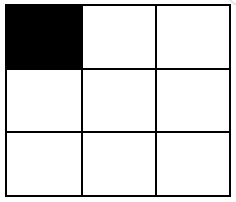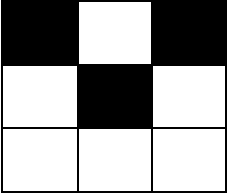g2701_2800.s2768_number_of_black_blocks.readme.md Maven / Gradle / Ivy
Go to download
Show more of this group Show more artifacts with this name
Show all versions of leetcode-in-kotlin Show documentation
Show all versions of leetcode-in-kotlin Show documentation
Kotlin-based LeetCode algorithm problem solutions, regularly updated
2768\. Number of Black Blocks
Medium
You are given two integers `m` and `n` representing the dimensions of a **0-indexed** `m x n` grid.
You are also given a **0-indexed** 2D integer matrix `coordinates`, where `coordinates[i] = [x, y]` indicates that the cell with coordinates `[x, y]` is colored **black**. All cells in the grid that do not appear in `coordinates` are **white**.
A block is defined as a `2 x 2` submatrix of the grid. More formally, a block with cell `[x, y]` as its top-left corner where `0 <= x < m - 1` and `0 <= y < n - 1` contains the coordinates `[x, y]`, `[x + 1, y]`, `[x, y + 1]`, and `[x + 1, y + 1]`.
Return _a **0-indexed** integer array_ `arr` _of size_ `5` _such that_ `arr[i]` _is the number of blocks that contains exactly_ `i` _**black** cells_.
**Example 1:**
**Input:** m = 3, n = 3, coordinates = [[0,0]]
**Output:** [3,1,0,0,0]
**Explanation:** The grid looks like this: 
There is only 1 block with one black cell, and it is the block starting with cell [0,0].
The other 3 blocks start with cells [0,1], [1,0] and [1,1]. They all have zero black cells.
Thus, we return [3,1,0,0,0].
**Example 2:**
**Input:** m = 3, n = 3, coordinates = [[0,0],[1,1],[0,2]]
**Output:** [0,2,2,0,0]
**Explanation:** The grid looks like this: 
There are 2 blocks with two black cells (the ones starting with cell coordinates [0,0] and [0,1]).
The other 2 blocks have starting cell coordinates of [1,0] and [1,1]. They both have 1 black cell.
Therefore, we return [0,2,2,0,0].
**Constraints:**
* 2 <= m <= 105
* 2 <= n <= 105
* 0 <= coordinates.length <= 104
* `coordinates[i].length == 2`
* `0 <= coordinates[i][0] < m`
* `0 <= coordinates[i][1] < n`
* It is guaranteed that `coordinates` contains pairwise distinct coordinates.